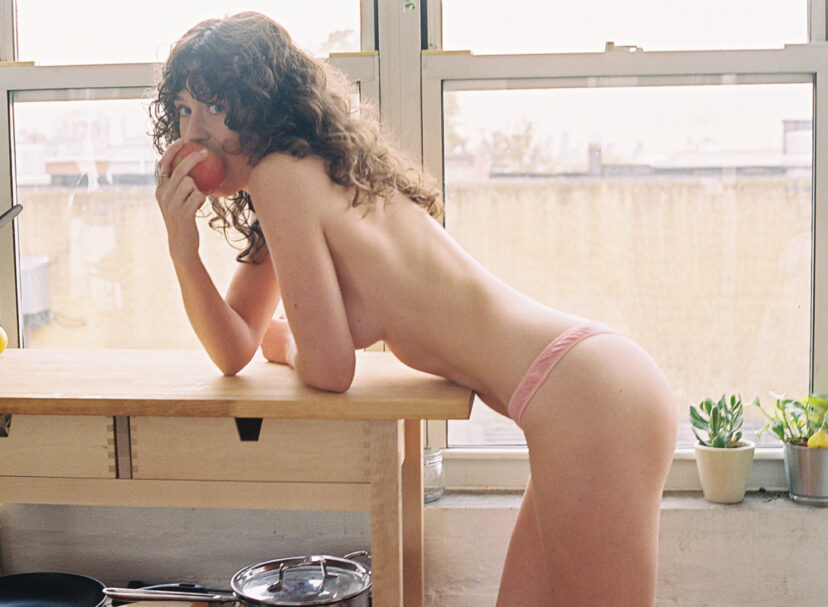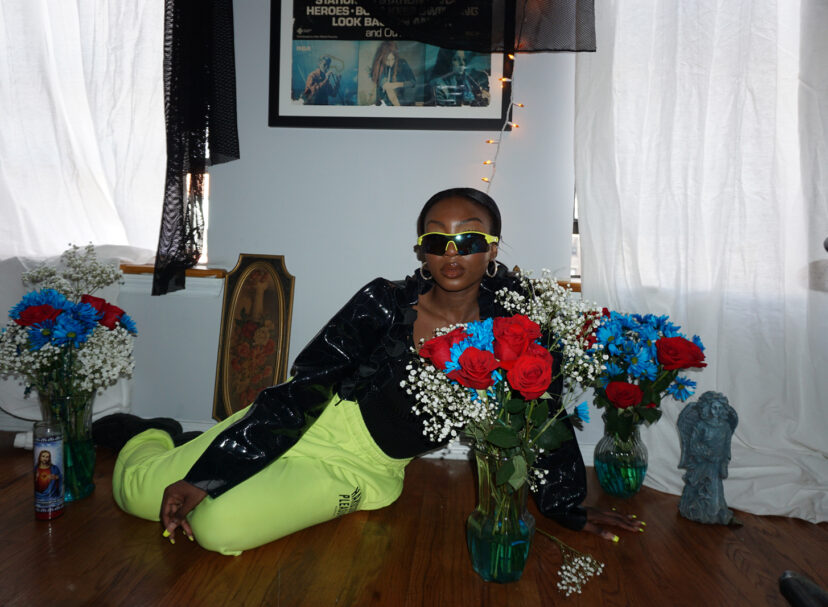Photos: Kat Slootsky
Text And Interview: Monica Uszerowicz
Designer Katie Gallagher’s work has grown from what might’ve been the utilitarian trappings of a cyborg to the flowy, romantic underpinnings of an especially tough woman in love—but even an increase in their wearability has borne no influence on their strange, otherworldly edge. Gallagher draws her designs, it seems, from the same place that inspired her paintings, the medium she assumed she’d study while at RISD. She selected Apparel Design instead, and ultimately went directly from graduation to New York Fashion Week, her textured details and beautifully peculiar aesthetic garnering immediate praise.
We love the way she pays homage to the body, her shapes referencing its curves and its dark palette honoring, it seems, its interior structure (even the blood). We spoke with Gallagher about her history, her current collection, and her inspirations—see below.

You studied apparel design at RISD, but you went there with the intention of majoring in painting. How did you transition into your particular line of work? How does your initial love of another art form play out in your designs?
Painting and drawing has everything to do with what I do in terms of my clothing line. I paint and draw before I begin patternmaking or constructing anything. It helps me describe what I am imagining for the season to myself. I would feel so worthless if I was one of those designers who can’t draw or construct a garment.
I decided after a lot of thought, during my freshman year at RISD, that being a “painter,” or having a degree in such, would never pay my loans—the thousands and thousands I was taking out to be there. Scholarships aside, I would be in deep trouble in four years—and wouldn’t be able to do much of anything, really. I wasn’t like most of the RISD kids; my daddy wasn’t footing any of my bills. I couldn’t even buy books or the food I wanted to eat. I learned how to steal hard.
It was a logical decision to get a degree and obtain a skill set that I could apply to a commercial job if I wanted to. I closed my eyes and wrote “Apparel Design” on my form. My 3D teacher said to me, “You know, Apparel Design is a 3D major,” implying that I was not the greatest student she ever had in class. My drawing teacher stopped talking to me. Not even joking.
I liked the idea of deciding how people should look—how I wanted to look. I hated shopping because nothing ever fit me how I wanted it to. I almost switched out of Apparel Design my sophomore year. I didn’t get it. All the math and measuring drove me insane. It all clicked one day. Likely overnight.


I love reading about your childhood in other interviews. It seems you were close to your grandparents, always creative, and generally a daydreamer. Can you tell me about creating and making art when you were very young?
I love to tell childhood stories. I had a great one. When I was a child, for me, it wasn’t really about creating “art.” It was all about exploring nature, inventing scenarios for everything, making every holiday—especially Halloween—an enormous and very important event. I had the mom that would serve us a cherry pie when we got home from school because it was President’s Day. And just being with my sisters—we were always creating “potions” out of mud and mushrooms, making up soap operas regarding our Barbies’ lives.
I liked to doodle, but I was most interested in watching everything. I did have a plastic crate of scrap paper, usually blue. I would draw something and show it to my grandpa and ask, “Is this good yet?” I was a very competitive child.
It seems you went straight from school to New York Fashion Week, but what was the process like for you? I imagine it was fantastic but overwhelming.
I did and it was. It did, however, happen very organically. My boyfriend and business partner at the time, like me, was fearless. We built the initial show together and fought till we couldn’t.
Kate Lanphear, in turn, listed my show in her top 5 NYFW shows for the Spring/Summer ’10 season and I.T. in Hong Kong and Seven New York bought the line, and so Fall/Winter ’10 had to happen. By Halloween, I already had two pieces made.


Your collections feel like entire microcosms or parts of a storyline. Is creating an imagined narrative part of your process?
Yes, I like to create a scene—a story. I imagine who would live there and what they would look like. Clothes describe who we are. They can tell our story, mood, personality, and ideals.
Your earlier collections were described as “futuristic” and “sci-fi,” but they were definitely very human, too. Your current collections are understood as more wearable. Is this a conscious decision?
Let’s be real. I’m not designing for forest creatures or cyborgs. I used to believe I could, but not many of them can afford my clothes. It is a conscious decision, sure. Wearable or not, though, the design details and brand identity will always be there. I have always said that I would never design something that I wouldn’t wear. As a woman who is aging with the collection, this is what I want to wear now. My inspiration is ever changing. I love having themes for the season and going off on just that—until the next season.
Can you tell me about the Fall/Winter 2016 and Spring/Summer 2016 collections? Fall/Winter is so romantic, while Spring/Summer feels “edgy”—a word I hate, but I mean they’re quite literally edgy; there is such a focus on the details of the edges, the cutouts, the unusual hemming.
Fall/Winter ’16 and Spring/Summer ’16 are quite different. Spring/Summer ’16, “Chinatown,” was inspired by my Chinatown in New York City—the colors, most importantly. It is my favorite place in the city and the place where each collection has been created since season one.
Fall/Winter ’16, “Veiled”, was inspired by my original concept, Spring/Summer 2010, “Veil.” I reworked some of my favorite pieces and elevated them to the current season and timeline for he brand and what Katie Gallagher as a fashion label has always been about: a monochromatic black collection relying heavily on textures and subtle details, craft, and creativity.
What are you working on now? Do you ever find downtime to paint, or simply to relax?
I am currently working on Spring/Summer ’17 and some illustrations. I don’t really prefer to relax in a common sense. My idea of relaxation is getting things done. I don’t like to sleep but I do love drinking wine and swimming pools. But I would like a swimming pool best with an easel set up next to it and a sewing machine handy.




